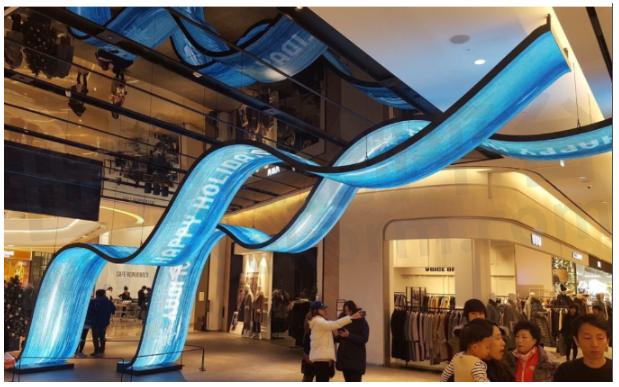LED Display Brightness

Brightness of an LED display varies a lot according to different application scenarios. Generally, outdoor LED displays need higher brightness to gain more visibility in strong ambient light. But indoor LED displays require less in brightness since indoor environment is much darker. It’s an advantage to protect your eyes while using an LED display with lower brightness when watch the screen indoors. That’s why someone emphasize brightness more while others may focus on other features while choosing an LED display. So what’s the logic behind the brightness of LED displays? Believe me, it’s worth to spend a few minutes over following paragraphs, and they’ll provide a complete guide over LED display brightness.

What is LED display brightness?
LED display brightness defines the level of the light emitted by the LEDs (light emitting diode) that compose an LED display. We usually describe it by numerical value in cd/m2 or nits. The higher value, the higher brightness of an LED display. For example, a 10,000 nits outdoor LED display is much brighter than an 800 nits indoor LED display.

Kinglight provides various LEDs in different brightness
Why brightness is important for LED displays?
When we read the specifications of an LED display, brightness always appears at the most conspicuous position. Why? That’s because brightness plays an important role for the overall performance of an LED display.
1st, as we mentioned in the beginning, brightness can be accommodated into different application scenarios. It’s a decisive factor for the visibility of an LED display in different environments.
2nd, brightness is an element that affects other features of an LED display, including contrast ratio, grayscale, and color saturation. Without enough brightness, it’s an empty talk over these important features, which also decide the performance of an LED display a lot.
3rd, high brightness also contributes to the viewing angle of an LED display. That is to say, high brightness ensures the visibility when you watch the screen at the very off-center positions. LED displays with lower brightness usually have a limited viewing angle.
4th, high brightness brings great versatility for LED displays. High brightness LED displays can be applicable in different environments, including retail stores, airports, stadiums, transportation hubs, and more, where visibility and image quality are of utmost importance. On the opposite, lower brightness LED displays are limited only to indoor and dark places.
How much brightness does an LED display need?
Though high brightness is an advantage for LED displays, it increases the cost when you buy an LED display with higher brightness. So when we’re going to purchase an LED display, it’s better to consider where you’re going to place it and what content you’re going to display on the screen.
1.Decide brightness by places where an LED display operates
Generally, for an indoor LED display, the brightness should be within 800 nits to 2,500 nits, which depends on the specific ambient light conditions. Some indoor places may quite dark while other indoor environment maybe much brighter with sufficient sunlight coming in through glass walls or windows, or whatever else.
For an outdoor LED display, the brightness varies a lot since there are significant changes of light conditions in specific locations.
In outdoor places with shadows, the brightness of an LED display should be within 2,500 – 4,000 nits;
at places without strong direct sunshine, brightness between 3,500 – 5,500 nits are suitable;
at places with strong direct sunshine, the brightness for the LED display should be over 5,500 nits to ensure the visibility of the content.
And of course, the above brightness ranges are for reference. Since the specific environmental light condition varies significantly, it’s better to test what brightness level that works best for you; or you can consult with experienced operators of LED displays.
2.Contents being displayed is another factor you should consider
Different contents also make differences while choosing the appropriate brightness for an LED display, especially for indoor usages.
If you’re going to display only text, then 200 – 300 nits brightness is applicable;
if you only do a video playback, 400 – 600 nits brightness works;
if you’re operating advertisement for the best visual experience, the brightness should be between 600 and 1,000 nits.

Kinglight 2727-A4-T70 LED features 14,000 nits for ultra high brightness LED displays
In conclusion, brightness is crucial for LED displays to ensure visibility, enhance image quality, and create impactful visual experiences. The ability of LED displays to deliver high brightness levels sets them apart from other display technologies and makes them well-suited for a variety of applications and environments. But when choose an LED display, it’s better to take above mentioned factors into consideration e display, and select an appropriate brightness to meet your specific requirement and reduce the overall cost.
- +1 Like
- Add to Favorites
Recommend
- How to Make a 3D LED Display and What is the Advantages of a 3D LED Display
- Kinglight All Scenarios LEDs Shine at InfoComm 2024
- How Much Does An LED Dance Floor Cost
- Why Kinglight KS Series LEDs Provide 5 Years Warranty
- Kinglight XR Series & 1515RGBW LEDs for LED Virtual Production
- Kinglight 2727-KS4 LED Contributes to UEFA Euro 2024
- Kinglight Driver IC Integrated LEDs for Transparent LED Display (II)
- Kinglight Debuted at SLS Expo 2024 with Brand New LEDs for Displays
This document is provided by Sekorm Platform for VIP exclusive service. The copyright is owned by Sekorm. Without authorization, any medias, websites or individual are not allowed to reprint. When authorizing the reprint, the link of www.sekorm.com must be indicated.





























































































































































































































































































































































































































































































































































































































































































































































































































































































